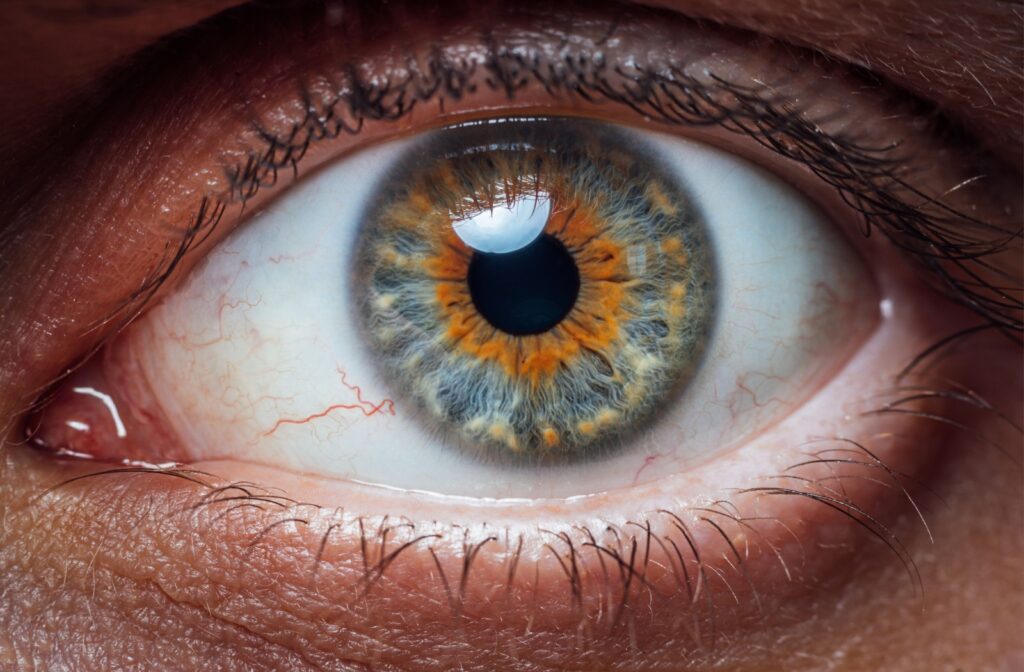You look in the mirror and notice tiny red lines across the whites of your eyes. These are blood vessels, and they are always there. Most of the time, they’re so small you don’t see them.
Visible veins are usually a temporary and normal response to irritation, but persistent redness can sometimes be a sign your eyes need professional attention. When the veins in your eyes become more visible, this is often a signal that your eyes are working hard or reacting to something in your environment.
Why You See Veins & Common Causes
Your eyes have tiny veins or blood vessels that deliver oxygen and nutrients. These blood vessels are located on the white part of your eye, the sclera, and they’re covered by a thin, clear membrane called the conjunctiva. Usually, they’re nearly invisible.
When your eyes get irritated or strained, these blood vessels can swell and expand. This expansion, called vasodilation, makes them much more noticeable against the white of your eye. This is your body’s natural response to a wide range of triggers.
Often, visible veins are a temporary reaction to your daily habits or surroundings. Certain triggers can cause redness that typically goes away after some rest or once the irritant is removed. You can often connect the redness to a specific activity or condition.
Lifestyle & Environmental Triggers
Everyday situations can easily lead to temporary eye redness. Your body is simply reacting to an external factor. Common causes of redness include:
- Irritants like dust, pollen, or smoke
- Exposure to sunlight or dry air
- Chemicals from shampoo or swimming pool chlorine
- Digital eye strain from a lot of screen time
- Improper wear or overuse of contact lenses
Health & Wellness Factors
Your overall health can also affect your eyes. Sometimes, what’s happening inside your body shows up as redness on the outside. Factors related to your well-being include:
- Lack of sleep
- Dehydration
- Crying or high stress
- A common cold or the flu
- Allergies, which can sometimes lead to allergic conjunctivitis

When Red Eyes Point to Other Conditions
Sometimes, persistent redness is a sign of an underlying eye condition that can benefit from professional care. These conditions are often accompanied by other symptoms like discomfort, discharge, or changes in your vision. A thorough eye disease assessment can help identify the cause.
If your red eyes don’t clear up, it’s helpful to be aware of other possibilities. Some common eye conditions associated with redness include:
- Blepharitis: Inflammation that causes swollen or itchy eyelids.
- Conjunctivitis: Also known as pink eye, this is an infection or inflammation of the conjunctiva.
- Corneal Ulcers or Scratches: Sores or injuries on the cornea, often from an infection or contact lens issues.
- Uveitis: Inflammation of the uvea, the middle layer of the eye.
- Acute Glaucoma: A sudden increase in eye pressure that may cause pain and vision problems. This is a medical emergency and requires immediate attention.
How You Can Help Your Eyes at Home
You can take simple steps to prevent irritation and keep your eyes comfortable. Small adjustments to your daily routine can make a big difference in how your eyes feel. These proactive habits support overall eye health.
By incorporating a few easy practices, you can help reduce strain and minimize redness. Consider these helpful tips:
- Follow the 20-20-20 Rule: Every 20 minutes, look at something 20 feet away for at least 20 seconds to give your eyes a break from screens.
- Stay Hydrated: Drink plenty of water throughout the day to help your body function well, including tear production.
- Use Eye Drops: Over-the-counter artificial tears can help lubricate your eyes and soothe symptoms of dry eye.
- Wear Sunglasses: Protect your eyes from sun exposure, which can cause irritation and dryness.
- Get Enough Sleep: Aim for a full night’s rest to let your eyes recover and repair.
What About a Bright Red Spot?
A bright red patch on the white of your eye may look alarming, but it’s usually a subconjunctival hemorrhage. This is essentially a broken blood vessel on the surface of your eye. It’s a common and often harmless occurrence.
This can happen from something as simple as a strong cough, a sneeze, or straining. Though it looks dramatic, it is typically painless and doesn’t affect your vision. Think of it like a bruise on your skin. The red spot will change colors and fade on its own over one to two weeks. Usually, no treatment is needed for it to heal.
When to See an Eye Doctor in San Diego
While many cases of red eyes resolve on their own, certain signs show it’s time to schedule a visit. If you experience persistent redness along with other symptoms, you should have your eyes checked. A conversation with your eye doctor can help you get the right care.
Pay attention to what your eyes are telling you. Prompt attention to new or changing symptoms can help keep your eyes healthy. It’s a good idea to seek a professional opinion for peace of mind.
Reasons to Schedule an Appointment
If you notice any of the following signs in addition to redness, it’s a good time to make an appointment. An eye exam can determine the cause of your symptoms. Let us know if you experience:
- Redness that lasts for more than two days
- You have eye pain or vision changes
- Your eyes are very sensitive to light
- You see halos around lights
- You have a yellow or greenish discharge from your eye
- The redness appeared after an eye injury
Your eye health is an important part of your overall wellness. Paying attention to your eyes’ signals is a great proactive step, even if the cause is minor. Knowing when to seek care is key to maintaining clear and comfortable vision.
If you’re experiencing persistent redness or have any other concerns, we’re here to help. Contact us at Total Vision Sports Arena to schedule a comprehensive eye exam with an eye doctor in San Diego. We are ready to help you keep your eyes healthy and happy.



